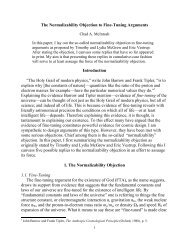Theism and Explanation - Appeared-to-Blogly
Theism and Explanation - Appeared-to-Blogly
Theism and Explanation - Appeared-to-Blogly
Create successful ePaper yourself
Turn your PDF publications into a flip-book with our unique Google optimized e-Paper software.
108 <strong>Theism</strong> <strong>and</strong> <strong>Explanation</strong><br />
a “best explanation” account of what he calls “biological information.” In<br />
the course of doing so, he argues inductively, from our previous experience<br />
of intelligent designers. But as I have already suggested (6.1.2), there is no<br />
evidence that Swinburne is offering an argument of this kind, one that<br />
refers <strong>to</strong> previous observed instances of the fact in question. Swinburne<br />
does claim that the explanation he is offering is a species of personal, or (as<br />
I have described it) intentional explanation. 35 So it is presumably an intentional<br />
explanation that meets the requirement of Peirce’s second premise by<br />
taking us from H <strong>to</strong> E. But other than assuming that it is probabilistic in<br />
form, Swinburne never spells out just what kind of argument this involves.<br />
My own view will by now be familiar. It is that an intentional explanation<br />
is best regarded as a species of deductive argument.<br />
6.2 THE BEST EXPLANATION<br />
It seems, then, that Swinburne’s arguments for the existence of God follow,<br />
more or less, the pattern of Peirce’s abductive schema. They are,<br />
therefore, best analysed as abductive arguments, of the form I discussed at<br />
the starting point of my enquiry (2.1.2). I shall argue in a moment (6.2.1)<br />
that abductive reasoning can be defended as a form of inference <strong>to</strong> the<br />
best explanation (IBE). And, as a number of authors have argued, 36 IBE<br />
is particularly well-adapted for a defence of theism. Firstly, it can be used<br />
<strong>to</strong> support the positing of unobservable (or at least unobserved) entities.<br />
To mount a directly inductive argument, of the kind offered by William<br />
Dembski (6.1.1), requires the theist <strong>to</strong> produce past instances in which this<br />
posited cause can be observed at work. But IBE allows us <strong>to</strong> posit a cause<br />
which we have never before observed at work. Secondly, <strong>and</strong> for precisely<br />
the same reason, IBE can be used <strong>to</strong> support singular causal claims (4.2.1).<br />
Even if we know of only one event of the type in question (such as the “big<br />
bang,” commonly, but no longer universally, 37 thought <strong>to</strong> mark the beginning<br />
of our universe), we can legitimately posit a cause <strong>and</strong> argue for its<br />
existence in the manner Peirce indicates. All we need is a non-inductive way<br />
of arguing that “if H were true, E is what we would expect” (2.1.2), that is<br />
<strong>to</strong> say, one that does not need <strong>to</strong> appeal <strong>to</strong> past instances of this correlation.<br />
And in the case of intentional explanations, this is precisely what we have<br />
(Appendix 1.3), in the form of the rationality principle (5.2).<br />
6.2.1 The Problem of Abduction<br />
But I’m now jumping ahead of myself. Let me return <strong>to</strong> the question of<br />
abduction, for at fi rst sight this might seem a poor kind of argument. To<br />
Peirce’s credit, he is very careful in the wording of his schema. Its conclusion<br />
is not “H is true,” but “there is reason <strong>to</strong> suspect H is true.” But let’s be<br />
less cautious for a moment, <strong>and</strong> formulate an abductive argument without<br />
such qualifi cations.



